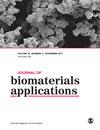Advancements in self-assembling peptides: Bridging gaps in 3D cell culture and electronic device fabrication
IF 2.3
4区 医学
Q3 ENGINEERING, BIOMEDICAL
引用次数: 0
Abstract
Self-assembling peptides (SAPs) show promise in creating synthetic microenvironments that regulate cellular function and tissue repair. Also, the precise π-π interactions and hydrogen bonding within self-assembled peptide structures enable the creation of quantum confined structures, leading to reduced band gaps and the emergence of semiconductor properties within the superstructures. This review emphasizes the need for standardized 3D cell culture methods and electronic devices based on SAPs for monitoring cell communication and controlling cell surface morphology. Additionally, the gap in understanding the relationship between SAP peptide sequences and nanostructures is highlighted, underscoring the importance of optimizing peptide deposition parameters, which affect charge transport and bioactivity due to varying morphologies. The potential of peptide nanofibers as extracellular matrix mimics and the introduction of the zone casting method for improved film deposition are discussed within this review, aiming to bridge knowledge gaps and offer insights into fields like tissue engineering and materials science, with the potential for groundbreaking applications at the interface of biology and materials engineering.自组装肽的进展:弥合三维细胞培养和电子设备制造中的差距
自组装肽(SAP)有望创造出调节细胞功能和组织修复的合成微环境。此外,自组装肽结构中精确的π-π相互作用和氢键使量子约束结构得以创建,从而减少了带隙,并在超结构中出现了半导体特性。本综述强调了对标准化三维细胞培养方法和基于 SAP 的电子设备的需求,以监测细胞通讯和控制细胞表面形态。此外,还强调了在理解 SAP 肽序列与纳米结构之间的关系方面存在的差距,强调了优化肽沉积参数的重要性,因为不同的形态会影响电荷传输和生物活性。本综述还讨论了肽纳米纤维作为细胞外基质模拟物的潜力,以及为改进薄膜沉积而引入的分区浇铸法,旨在弥补知识差距,并为组织工程和材料科学等领域提供见解,有望在生物学和材料工程的交界处实现突破性应用。
本文章由计算机程序翻译,如有差异,请以英文原文为准。
求助全文
约1分钟内获得全文
求助全文
来源期刊

Journal of Biomaterials Applications
工程技术-材料科学:生物材料
CiteScore
5.10
自引率
3.40%
发文量
144
审稿时长
1.5 months
期刊介绍:
The Journal of Biomaterials Applications is a fully peer reviewed international journal that publishes original research and review articles that emphasize the development, manufacture and clinical applications of biomaterials.
Peer-reviewed articles by biomedical specialists from around the world cover:
New developments in biomaterials, R&D, properties and performance, evaluation and applications
Applications in biomedical materials and devices - from sutures and wound dressings to biosensors and cardiovascular devices
Current findings in biological compatibility/incompatibility of biomaterials
The Journal of Biomaterials Applications publishes original articles that emphasize the development, manufacture and clinical applications of biomaterials. Biomaterials continue to be one of the most rapidly growing areas of research in plastics today and certainly one of the biggest technical challenges, since biomaterial performance is dependent on polymer compatibility with the aggressive biological environment. The Journal cuts across disciplines and focuses on medical research and topics that present the broadest view of practical applications of biomaterials in actual clinical use.
The Journal of Biomaterial Applications is devoted to new and emerging biomaterials technologies, particularly focusing on the many applications which are under development at industrial biomedical and polymer research facilities, as well as the ongoing activities in academic, medical and applied clinical uses of devices.
 求助内容:
求助内容: 应助结果提醒方式:
应助结果提醒方式:


